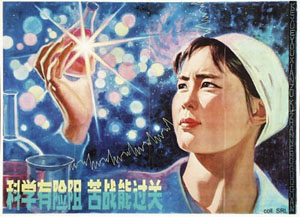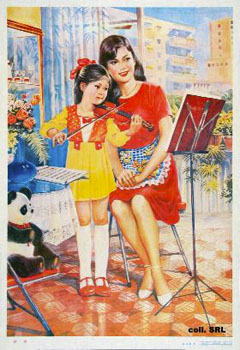I love the internet. I went from this, which I posted here, to this, to this, to this, to this:

. . . to this:

. . . . which is the work of Ha Qiongwen. Of this particular poster, Stefan Landsberger says:
The design reproduced above was at the root of Ha’s problems: why had he depicted a bourgeois woman instead of a female proletarian? Where was Chairman Mao? Why didn’t the poster praise the Chairman more explicitly? Every time the literature and arts world held a criticism session, he was dragged out as an object of public abuse. As a result, Ha was publicly beaten and humiliated more than thirty times.
Personally I think the Red Guards were on to something. I think these delightful and amazing Chinese propaganda posters and China’s current, rampantly aspirational and bourgeois rise towards superpowerdom are cause and effect.
I offered further thoughts along these lines in this ASI blog posting . This is the bit that is relevant:
I recently encountered, in a remainder shop, a big book containing hundreds of Chinese Communist propaganda posters, much like these ones. They depict a vivid and colourful fantasy world of industrial excellence and economic triumph, of collective progress and personal fulfilment, of joy. The people who now preside over China’s current economic miracle were teenagers when posters like these were at the height of their influence, and I think this is no coincidence. It makes perfect sense to me that the more imaginative and impressionable people brought up on imagery like this would turn away in disgust from the lumbering state centralism that these posters were intended to sell, once they realized that state centralism could never deliver such wonders, and instead switch to being enthusiastic pro-capitalists and even capitalist entrepreneurs. After all, only if China switched to capitalism could a real future like this be even hoped for, let alone rationally anticipated.
If you follow the link in that and scroll down to the bottom, you get to this:

Red Guards eat your hearts out.
(I now possess that book.)
Did Ayn Rand have anything to say about these Chinese posters? She should have.




One of my (many) failures of character has been a long love of propoganda in its most diverse forms, even when the aim of the propoganda is IMHO misguided (Chick comics) or repellent (Cultural Revolution).
The idea that human nature (with all it’s messy motivations and dark desires) can be changed and purified is the alchemy of the 20th century.
Yet, people (being human) just like the alchemists are not letting the vast failures of past attempts deter them from further efforts. There’s something hypnotic about art that’s built on the principle that human nature is changeable and malleable (one of the things that made Star Trek so attractive for so long).
Ayn Rand’s novels are of course just as much political/phisophical propoganda as was Bright Red Star (a cultural revolution novel I enjoyed). She leached almost all the humanity out of her characters (hero and villain alike) turning them into archetypes whose behaviors and fates conveniently fulfilled her fantasies about how people should behave.
I think Rand woud appreciate the technique of a lot of the Chinese posters (many of which are stunningly beautiful in their own horribly misguided way) but not the goals/motivations of the creators and would therefore dismiss them.
Thanks to Steven Landsberger for collecting all the art. I’ve had a lot of fun with it, and frankly, if China had this art spread around now, it would be a big improvement over the vulgar and garish sights on the streets.
These pieces of art are beautiful. The effect of a visual representation to achieve a certain given objective is very effective propaganda.
Just for fun, the words on the first poster says, “Science has many barriers, but determination can overcome”.
The second says, “Longevity to Chairman Mao.” Probably to commemerate his birthday or something like that. Explains why poor Ha got abused.
TWG
What is remarkable about most of these posters is how non-political they are. Although it is vaguely disturbing to see the caucasian mother and daughter, in a familiar Chinese setting. Is this a kinder gentler way of saying, Communism will bury us? Or in this case, that we will embrace finally (their) Chinese values. Interesting to see so many images of women in a county which practised matricide for many years. And the poster of woman and child, opposite the profile of a mans face superimposed over a barred window, might be social commentary on family life inside America’s inner cities. China has long treated political dissidents and common criminals alike. I tend to attribute more originality to the artists who made these posters, and less to the government propoganda service which approved them.
All of this art is steeped in nostalgia. It looks great now, but if you can cast your mind back to the time of Mao, in the swinging sixties, it was considered most definitely uncool.
A common theme in much of this artwork, particularly the posters from the 1980’s, is sacrifice and effort now for a future utopian life. This reminds me of the postwar years in the west, from the American dream in the late 1940’s to the white heat of technology of the early 1960’s. Was there a connection between this official optimism and our 1980’s/1990’s boom years? I can’t help wondering whether propaganda has more power than we realise to influence the psychology and outcome of a culture. We have the Chinese dream, as depicted in these posters, preceding the current rise of China to become a world superpower. On the other hand, we see decay, guilt, and self loathing taking over as popular themes in the west. Is this mindset merely predicting or causing an inevitable decline.
“””Although it is vaguely disturbing to see the caucasian mother and daughter,””””
Excuse me, but that IS NOT a CAUCASIAN mother and daughter. They are supposed to be Chinese! Really.
Am I the only one who has noticed that ComChi propaganda posters makes the people in them look Eurasian rather than ethnic Chinese? Look again at the selections offered, as well as any other collection of such posters, and tell me if I’m imagining this.
Brian, if you look at some of the posters of curvy American young ladies selling soap powder, driving cars or whatnot, the aesthetic is not that different: young, fresh faces, smiling eyes, bright, vibrant colours, all projecting a world of plenty and excitment. If that is propoganda, well then a lot of the art we see is as such.
I suspect Rand, who wrote some good and not-so-good stuff about what art is about, would quite like some of the aesthetics but deplore the totalitarian socialist vision behind it.
The next time anyone goes to a bookshop, look at the cover art on books like Atlas Shrugged. It could come out of the Soviet Union.
They look chinese enough to me…
TWG
Not only are the facial features consistent with a Caucasian woman and child, their bodies are slender, and delicate. The girl definitely has a non-asian form. What’s interesting is the stuffed Panda. The Panda is not a natural placement, but something symbolic. Why would the artist place that item in a domestic setting? You can also see things in the apartment setting which suggest a city like New York, and Central Park? Do the Chinese long for American middle class values? Would material desires be opposed to the function of Socialist Propoganda? Or does this represent the triumph of Socialist values over the decadent west?
db, Chinese apartments in the big cities look like the one in the poster now. I lived in one for a year that could almost be the one in the poster. And Chinese girls are often slender and delicate!
But there’s a point, the mom’s face does look a little caucasian.
Thanks for posting these posters, I’ve been interested in Social Realism for a while, and nice to see these books are available. The question seems to be are these images really propaganda. Assuming the images do reflect a Socialist vision, how are the elements constructed, and what is the effect on their intended audience. So where are all the men?
That lady looks like a good mom!!
david_will
Hookahshisha.com